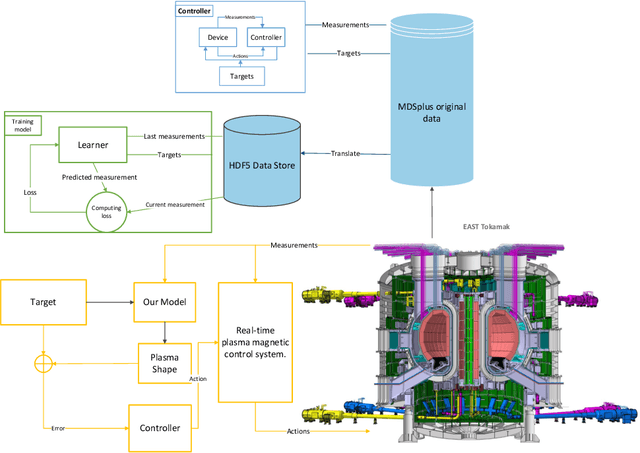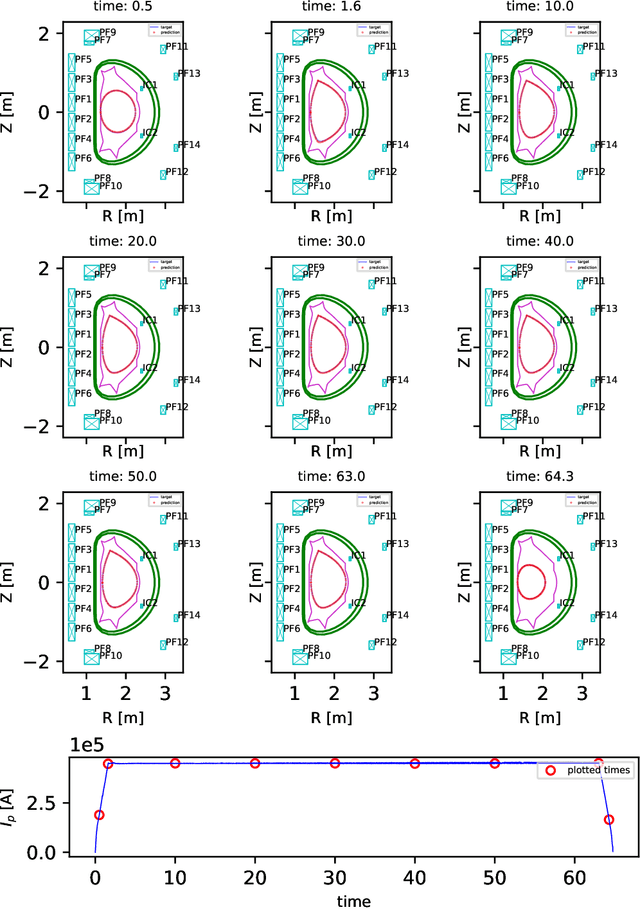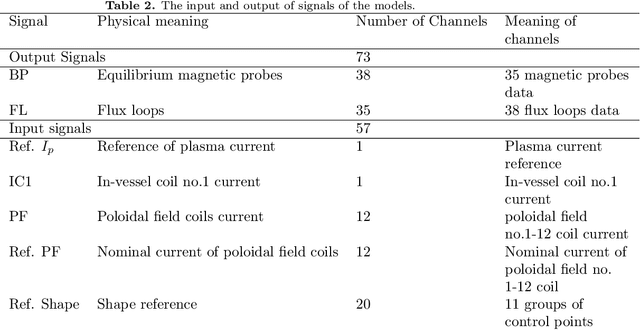Alessandro Pau
Plasma State Monitoring and Disruption Characterization using Multimodal VAEs
Apr 24, 2025Abstract:When a plasma disrupts in a tokamak, significant heat and electromagnetic loads are deposited onto the surrounding device components. These forces scale with plasma current and magnetic field strength, making disruptions one of the key challenges for future devices. Unfortunately, disruptions are not fully understood, with many different underlying causes that are difficult to anticipate. Data-driven models have shown success in predicting them, but they only provide limited interpretability. On the other hand, large-scale statistical analyses have been a great asset to understanding disruptive patterns. In this paper, we leverage data-driven methods to find an interpretable representation of the plasma state for disruption characterization. Specifically, we use a latent variable model to represent diagnostic measurements as a low-dimensional, latent representation. We build upon the Variational Autoencoder (VAE) framework, and extend it for (1) continuous projections of plasma trajectories; (2) a multimodal structure to separate operating regimes; and (3) separation with respect to disruptive regimes. Subsequently, we can identify continuous indicators for the disruption rate and the disruptivity based on statistical properties of measurement data. The proposed method is demonstrated using a dataset of approximately 1600 TCV discharges, selecting for flat-top disruptions or regular terminations. We evaluate the method with respect to (1) the identified disruption risk and its correlation with other plasma properties; (2) the ability to distinguish different types of disruptions; and (3) downstream analyses. For the latter, we conduct a demonstrative study on identifying parameters connected to disruptions using counterfactual-like analysis. Overall, the method can adequately identify distinct operating regimes characterized by varying proximity to disruptions in an interpretable manner.
Robust Confinement State Classification with Uncertainty Quantification through Ensembled Data-Driven Methods
Feb 24, 2025Abstract:Maximizing fusion performance in tokamaks relies on high energy confinement, often achieved through distinct operating regimes. The automated labeling of these confinement states is crucial to enable large-scale analyses or for real-time control applications. While this task becomes difficult to automate near state transitions or in marginal scenarios, much success has been achieved with data-driven models. However, these methods generally provide predictions as point estimates, and cannot adequately deal with missing and/or broken input signals. To enable wide-range applicability, we develop methods for confinement state classification with uncertainty quantification and model robustness. We focus on off-line analysis for TCV discharges, distinguishing L-mode, H-mode, and an in-between dithering phase (D). We propose ensembling data-driven methods on two axes: model formulations and feature sets. The former considers a dynamic formulation based on a recurrent Fourier Neural Operator-architecture and a static formulation based on gradient-boosted decision trees. These models are trained using multiple feature groupings categorized by diagnostic system or physical quantity. A dataset of 302 TCV discharges is fully labeled, and will be publicly released. We evaluate our method quantitatively using Cohen's kappa coefficient for predictive performance and the Expected Calibration Error for the uncertainty calibration. Furthermore, we discuss performance using a variety of common and alternative scenarios, the performance of individual components, out-of-distribution performance, cases of broken or missing signals, and evaluate conditionally-averaged behavior around different state transitions. Overall, the proposed method can distinguish L, D and H-mode with high performance, can cope with missing or broken signals, and provides meaningful uncertainty estimates.
Learning Plasma Dynamics and Robust Rampdown Trajectories with Predict-First Experiments at TCV
Feb 17, 2025Abstract:The rampdown in tokamak operations is a difficult to simulate phase during which the plasma is often pushed towards multiple instability limits. To address this challenge, and reduce the risk of disrupting operations, we leverage recent advances in Scientific Machine Learning (SciML) to develop a neural state-space model (NSSM) that predicts plasma dynamics during Tokamak \`a Configuration Variable (TCV) rampdowns. By integrating simple physics structure and data-driven models, the NSSM efficiently learns plasma dynamics during the rampdown from a modest dataset of 311 pulses with only five pulses in the reactor relevant high performance regime. The NSSM is parallelized across uncertainties, and reinforcement learning (RL) is applied to design trajectories that avoid multiple instability limits with high probability. Experiments at TCV ramping down high performance plasmas show statistically significant improvements in current and energy at plasma termination, with improvements in speed through continuous re-training. A predict-first experiment, increasing plasma current by 20\% from baseline, demonstrates the NSSM's ability to make small extrapolations with sufficient accuracy to design trajectories that successfully terminate the pulse. The developed approach paves the way for designing tokamak controls with robustness to considerable uncertainty, and demonstrates the relevance of the SciML approach to learning plasma dynamics for rapidly developing robust trajectories and controls during the incremental campaigns of upcoming burning plasma tokamaks.
A machine-learning-based tool for last closed magnetic flux surface reconstruction on tokamak
Jul 12, 2022



Abstract:Nuclear fusion power created by tokamak devices holds one of the most promising ways as a sustainable source of clean energy. One main challenge research field of tokamak is to predict the last closed magnetic flux surface (LCFS) determined by the interaction of the actuator coils and the internal tokamak plasma. This work requires high-dimensional, high-frequency, high-fidelity, real-time tools, further complicated by the wide range of actuator coils input interact with internal tokamak plasma states. In this work, we present a new machine learning model for reconstructing the LCFS from the Experimental Advanced Superconducting Tokamak (EAST) that learns automatically from the experimental data of EAST. This architecture can check the control strategy design and integrate it with the tokamak control system for real-time magnetic prediction. In the real-time modeling test, our approach achieves over 99% average similarity in LCFS reconstruction of the entire discharge process. In the offline magnetic reconstruction, our approach reaches over 93% average similarity.
 Add to Chrome
Add to Chrome Add to Firefox
Add to Firefox Add to Edge
Add to Edge